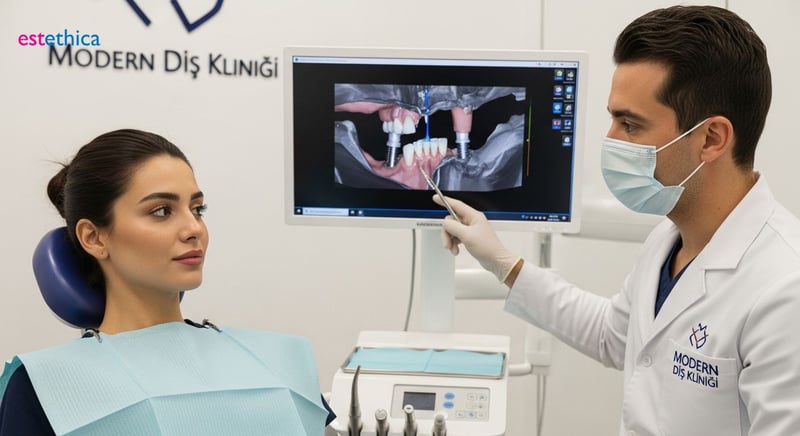Dental Implants: Your Smile Restoration Guide
Discover the benefits, types, and treatment process of dental implants, a leading solution for missing teeth.
Understanding the Dental Implant Treatment Process
Embarking on the journey to replace missing teeth with dental implants involves a carefully planned sequence of procedures designed to restore both function and aesthetics. Understanding the stages of the dental implant treatment process can help alleviate any anxieties and prepare you for the rewarding outcome. The initial phase is crucial for establishing a solid foundation for the entire procedure.
Initial Consultation and Planning
Your journey begins with a comprehensive dental examination. This isn't just a visual check; it often involves advanced imaging techniques such as X-rays and possibly a CT scan. These tools provide your dental professional with a detailed view of your jawbone density, nerve pathways, and sinus cavities. This meticulous assessment is vital for determining if you are a suitable candidate and for precisely planning the optimal placement of the implant post. This stage ensures that the procedure is tailored to your unique oral anatomy, maximizing the chances of success and minimizing potential complications.
Surgical Placement and Osseointegration
Once suitability is confirmed, the first major step in the dental implant treatment process is the surgical placement of the implant post. Typically crafted from biocompatible titanium, this post is carefully inserted directly into the jawbone. It serves as a robust artificial root, designed to integrate seamlessly with your natural bone structure. Following the surgery, a critical healing period ensues, which can last for several months. During this time, a remarkable biological process called osseointegration occurs. This is where your jawbone grows and fuses with the titanium implant, creating an exceptionally stable and strong anchor for the future restoration. Patience during this phase is key to achieving long-term stability.
Restoration Attachment and Completion
After successful osseointegration, the next step involves attaching an abutment to the implanted post. The abutment acts as a connector or a base, bridging the gap between the implant fixture firmly embedded in your bone and the visible restoration. Finally, a custom-made crown, bridge, or denture is attached to the abutment. This final restoration is meticulously crafted to match the color, shape, and size of your natural teeth, ensuring a beautiful and functional result. Throughout the entire dental implant treatment process, maintaining excellent oral hygiene and attending regular dental check-ups are paramount for the longevity of your implants and to ensure you achieve the best possible results for your missing tooth solutions. For a more in-depth understanding of what dental implants entail, you might find Dental Implants: Your Guide to a Restored Smile to be an excellent resource. The benefits of dental implants extend far beyond mere aesthetics, significantly improving chewing ability and overall oral health.

Discover the Benefits of Dental Implants
Opting for dental implants offers a multitude of advantages over traditional tooth replacement options. When considering your choices, it's crucial to understand the profound impact these advanced restorations can have on your oral health and overall well-being. One of the most significant benefits of dental implants is their exceptional longevity; when properly cared for, they can indeed last a lifetime, making them a truly cost-effective long-term investment in your smile and health. This durability sets them apart from many other restorative solutions.
Unmatched Stability and Functionality
Unlike removable dentures or fixed bridges, implants are surgically anchored directly into the jawbone. This integration provides unparalleled stability, effectively preventing the common issue of bone loss that often occurs after tooth extraction. By stimulating the jawbone, they help maintain your natural facial structure and prevent the sunken appearance that can accompany toothlessness. This robust foundation means you can eat, speak, and smile with complete confidence. Because they function and feel just like your natural teeth, you’ll experience no slippage or discomfort, allowing you to enjoy your favorite foods and engage in conversations without hesitation.
Preserving Your Natural Smile
Furthermore, the benefits of dental implants extend significantly to the preservation of your surrounding teeth. Traditional bridges, for instance, often require the grinding down of adjacent healthy teeth to create abutments. This process can compromise the integrity of otherwise sound teeth. In stark contrast, dental implants stand alone. They are self-supporting, leaving your natural dentition completely intact and undisturbed. This is a key consideration for anyone seeking effective tooth replacement solutions that prioritize the health of their entire mouth. For a more comprehensive understanding of what dental implants entail, including pricing and available brands, you can refer to Dental Implants: Your Guide to Current Prices, Benefits, and Brands.
Aesthetically Superior Results
The aesthetic outcomes with dental implants are also highly predictable and remarkably natural. Each implant crown is custom-made to perfectly match the color, shape, and size of your existing teeth. This meticulous attention to detail ensures a seamless integration with your smile, making it virtually indistinguishable from natural teeth. The result is a confident, beautiful, and complete smile that enhances your appearance and self-esteem. Exploring the possibilities of dental implant treatment process can lead to a significantly improved quality of life.
Exploring Different Types of Dental Implants
The world of dental restoration offers a variety of solutions to address missing teeth, and understanding the different dental implants available is a crucial step in finding the best approach for your unique needs. Your dentist will guide you through these options, considering your oral health, bone density, and aesthetic goals. To gain a comprehensive understanding, you might find it helpful to read more about Dental Implants: Transform Your Smile Today, which provides an excellent overview of the entire journey.
Understanding the Primary Implant Categories
The most prevalent category is the endosteal implant. These are meticulously designed to be surgically placed directly into the jawbone. Typically resembling screws or cylinders, they serve as a robust artificial root for your new tooth. Endosteal implants are a highly effective and durable choice for individuals who possess sufficient healthy jawbone density to support the implant securely. The success of the dental implant treatment process often hinges on this foundational support.
For patients who have experienced significant bone loss or are not suitable candidates for bone grafting procedures, subperiosteal implants present a viable alternative. Unlike endosteal implants, these consist of a custom-fitted metal framework that rests directly on the jawbone, beneath the gum tissue. Small posts then protrude through the gums, providing anchorage points for the artificial teeth. While less common than their endosteal counterparts, they offer a valuable solution when bone height is insufficient for traditional implants.
An innovative advancement in restorative dentistry is the advent of same-day implants, often referred to as immediate load implants. This technique allows for temporary, and sometimes even final, restorations to be attached on the very same day the implant post is surgically placed. This significantly shortens the overall treatment timeline, offering a quicker path to a restored smile and contributing to the benefits of dental implants by minimizing disruption.
The selection of the appropriate dental implant is a collaborative decision between you and your dental professional. Each type of dental implant offers distinct advantages, and understanding these differences is paramount to achieving successful and aesthetically pleasing missing tooth solutions. The expertise of your dentist in navigating the dental implant treatment process ensures that the chosen method best suits your individual anatomy and health status, maximizing the benefits of dental implants.

Comparing Dental Implants to Other Tooth Replacement Options
When faced with the challenge of a missing tooth, exploring various solutions is a natural first step. While bridges and dentures have long been traditional choices, it's crucial to understand how they stack up against modern advancements like dental implants. Often, traditional bridges are recommended when surrounding teeth are healthy and strong. However, this approach necessitates preparing, or "shaving down," these healthy adjacent teeth to support the bridge. This irreversible step can leave those supporting teeth more vulnerable to decay and nerve issues down the line, potentially leading to further dental work.
Understanding the Differences
Dentures offer a less invasive alternative, providing a removable option for replacing multiple teeth. While they can restore aesthetics and some chewing function, they come with their own set of considerations. Dentures can sometimes impact speech clarity and may require dental adhesives for stability, which can be inconvenient. Furthermore, a significant drawback of both bridges and dentures is their inability to prevent the natural bone loss that occurs when a tooth root is no longer present. This resorption can lead to changes in facial structure and make future dental interventions more complex.
In stark contrast, dental implants provide a revolutionary approach. They are designed to mimic the natural tooth root, surgically placed directly into the jawbone. This unique characteristic is key to one of the primary benefits of dental implants: they stimulate the jawbone, actively preventing bone resorption. This preservation of bone is vital not only for maintaining facial aesthetics but also for providing a stable foundation for the new tooth. The comprehensive Restore Your Smile: Dental Implants & Cosmetic Dentistry Options highlights the aesthetic advantages alongside functional ones. While the dental implant treatment process can be more extensive than other methods, the outcomes are often superior in terms of longevity, stability, and a natural feel. The benefits of dental implants extend beyond mere tooth replacement, contributing significantly to overall oral health.
The long-term advantages of the dental implant treatment process, including bone preservation and a highly functional, integrated result, often outweigh the initial investment compared to less durable options. These are indeed some of the key benefits of dental implants. Understanding the full scope of the dental implant treatment process can help patients make an informed decision about the best long-term solution for missing teeth.

Modern Dental Implants for Comprehensive Smile Restoration
Dental implants offer a durable and natural-looking solution for missing teeth, expertly restoring both function and aesthetics. The treatment process is carefully planned, beginning with an initial consultation and detailed imaging to ensure suitability and map out the surgical placement. This meticulous approach underpins the success of modern dental implantology, providing effective missing tooth solutions.
The process involves surgical placement of the implant post, which then undergoes osseointegration, a critical phase where the implant fuses with the jawbone. Following successful integration, an abutment is attached, and finally, the custom-made restoration is secured, completing the smile restoration. This detailed sequence highlights the expertise involved in delivering a seamless and functional outcome.
Expertise in dental implantology is demonstrated through a deep understanding of jawbone integration and the nuances of various implant types. Whether utilizing endosteal implants, the most prevalent category, or subperiosteal implants for complex cases, practitioners apply advanced knowledge to achieve optimal results. This specialized knowledge ensures patients receive the best possible care for their unique needs.
Your Trusted Guide to Understanding and Obtaining Dental Implants
The journey to obtaining dental implants is made transparent and reassuring through detailed explanations of the entire treatment process. From the initial consultation and planning, involving advanced imaging like CT scans, to the surgical placement and osseointegration, every step is designed for patient comfort and success. This clarity builds confidence in the procedure.
Understanding the differences between dental implants and other tooth replacement options, such as dentures or bridges, is crucial for informed decision-making. The content emphasizes how implants integrate with the jawbone, preserving bone density and offering a long-term solution that looks and feels like natural teeth. This focus on patient education and evidence-based solutions fosters trust.
Patients seeking to restore their smile can rely on this comprehensive guide for insights into how to get dental implants effectively. The information covers everything from initial assessments to the final restoration attachment, ensuring a clear roadmap. This detailed breakdown alleviates concerns and highlights the predictable and positive outcomes associated with modern dental implants.